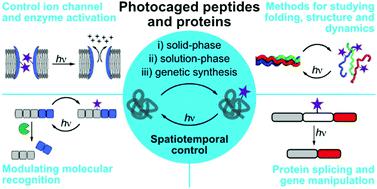当前位置:
X-MOL 学术
›
Chem. Soc. Rev.
›
论文详情
Our official English website, www.x-mol.net, welcomes your feedback! (Note: you will need to create a separate account there.)
Triggering biological processes: methods and applications of photocaged peptides and proteins
Chemical Society Reviews ( IF 46.2 ) Pub Date : 2021-07-28 , DOI: 10.1039/d0cs01434f Alicia E Mangubat-Medina 1 , Zachary T Ball 1
Chemical Society Reviews ( IF 46.2 ) Pub Date : 2021-07-28 , DOI: 10.1039/d0cs01434f Alicia E Mangubat-Medina 1 , Zachary T Ball 1
Affiliation

|
There has been a significant push in recent years to deploy fundamental knowledge and methods of photochemistry toward biological ends. Photoreactive groups have enabled chemists to activate biological function using the concept of photocaging. By granting spatiotemporal control over protein activation, these photocaging methods are fundamental in understanding biological processes. Peptides and proteins are an important group of photocaging targets that present conceptual and technical challenges, requiring precise chemoselectivity in complex polyfunctional environments. This review focuses on recent advances in photocaging techniques and methodologies, as well as their use in living systems. Photocaging methods include genetic and chemical approaches that require a deep understanding of structure–function relationships based on subtle changes in primary structure. Successful implementation of these ideas can shed light on important spatiotemporal aspects of living systems.
中文翻译:

触发生物过程:光笼肽和蛋白质的方法和应用
近年来,将光化学的基础知识和方法应用于生物学方面取得了重大进展。光反应基团使化学家能够使用光笼的概念激活生物功能。通过授予对蛋白质激活的时空控制,这些光笼方法是理解生物过程的基础。肽和蛋白质是一组重要的光笼目标,它们提出了概念和技术挑战,需要在复杂的多功能环境中具有精确的化学选择性。本综述重点关注光笼技术和方法的最新进展,以及它们在生命系统中的应用。Photocaging 方法包括遗传和化学方法,需要深入了解基于初级结构细微变化的结构-功能关系。这些想法的成功实施可以阐明生命系统的重要时空方面。
更新日期:2021-07-29
中文翻译:

触发生物过程:光笼肽和蛋白质的方法和应用
近年来,将光化学的基础知识和方法应用于生物学方面取得了重大进展。光反应基团使化学家能够使用光笼的概念激活生物功能。通过授予对蛋白质激活的时空控制,这些光笼方法是理解生物过程的基础。肽和蛋白质是一组重要的光笼目标,它们提出了概念和技术挑战,需要在复杂的多功能环境中具有精确的化学选择性。本综述重点关注光笼技术和方法的最新进展,以及它们在生命系统中的应用。Photocaging 方法包括遗传和化学方法,需要深入了解基于初级结构细微变化的结构-功能关系。这些想法的成功实施可以阐明生命系统的重要时空方面。


























 京公网安备 11010802027423号
京公网安备 11010802027423号